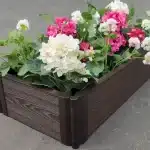Imagine a garden that enchants you with its charm not just in the spring or vibrant summer but every season. A garden that whispers the melody of nature’s cycle, flaunting its beauty in spring blooms, summer greens, autumnal hues, and winter’s serene whiteness. This vision can be your reality!
Dive into our comprehensive guide on year-round landscaping and journey into the world of perpetual beauty right in your own backyard. Unearth the secrets of maintaining a vibrant outdoor space, and let the rhythm of the seasons dance in your garden all year long.
The Importance of Year-Round Landscaping
When you embark on the journey of year-round landscaping, you are essentially painting a canvas that’s alive and evolving. Unlike a piece of art, however, a landscaped garden offers multiple benefits, from enhancing your home’s curb appeal and boosting property value to offering a safe haven for local wildlife. It’s an investment that brings returns in the form of pleasure, relaxation, and complimenting glances from neighbors and passersby.
The cornerstone of year-round landscaping is understanding the cycles your garden goes through. As the earth orbits around the sun, the change in seasons brings about shifts in climate and daylight hours, which impact how your plants grow and behave. Each season brings its own set of tasks and considerations, and understanding these helps you respond optimally to the needs of your outdoor space.
Spring Landscaping
Rejuvenating the Soil
Just as bears come out of hibernation in spring, the soil in your garden wakes up too. After being exposed to harsh winter conditions, it often needs rejuvenation. This may involve breaking it up with a tiller or garden fork (a process known as tilling), poking holes in it (aerating), or adding organic matter such as compost. These practices help enhance the soil structure, making it easier for roots to penetrate and improving its capacity to hold water and nutrients.
Plant Selection and Timing
Spring is synonymous with new beginnings; in the garden, this often means planting new flora.
When selecting plants, keep in mind their blooming periods. Choose a mix of early, mid, and late spring bloomers to ensure your garden remains vibrant throughout the season.
Pruning and Mulching
Spring is also the perfect time to prune your plants. Pruning involves removing old, dead, and diseased parts to encourage new growth and to let sunlight reach the center of the plant.
Mulching, on the other hand, involves covering the soil with organic matter like compost or wood chips, which helps to conserve soil moisture, suppress weed growth, and enrich the soil.
Summer Landscaping
Irrigation Essentials
As the days grow longer and temperatures rise, ensuring your plants get enough water becomes vital. Proper irrigation is critical in the summer months to prevent plants from wilting under the hot sun. Using automated irrigation systems or watering early in the morning or late in the evening can help prevent water loss through evaporation.
Pests and Disease Control
With the summer heat also comes pests and diseases that can threaten the health of your garden. Regular inspections and immediate response at the first sign of trouble can help keep your plants healthy and protect your landscape.
Focus on Foliage
While summer is often all about flowers, do not neglect the role of foliage in your landscape.
Green, vibrant leaves provide contrast to the bright flowers and add a unique aesthetic dimension to your garden. They also provide a lush, green backdrop to make your summer flowers stand out even more.
Autumn Landscaping
Preparing for Dormancy
Autumn is a time of preparation. As plants prepare for the dormant winter, you should adjust your care routine accordingly. This usually involves:
- Reducing the watering frequency.
- Halting the application of fertilizers.
- Carrying out measures to help plants harden off and better withstand winter conditions.
Leaf Management
Autumn, while known for its colorful foliage, also brings with it the task of leaf cleanup. If left unchecked, fallen leaves can suffocate your lawn and create a breeding ground for pests.
However, these leaves can also be a boon for your compost pile, breaking down to create rich, nutritious compost that can benefit your garden.
Planting Spring Bulbs
Autumn is the perfect time to plant spring-blooming bulbs like daffodils and tulips. These bulbs need a period of cold dormancy before they can bloom, so planting them in the fall ensures they get the chill they need and that your garden will burst into color come spring.
Winter Landscaping
Snow Management
Winter brings with it the challenge of snow. While beautiful, snow can cause damage to plants by weighing down branches and freezing roots. Timely snow removal and providing protective structures for vulnerable plants can help prevent damage.
Plant Protection
Certain plants, particularly those not native to cold climates, require extra protection during winter. This can be done by applying mulch, wrapping plants with burlap, or using protective structures like cloches or row covers.
Winter Pruning
When most plants are dormant, winter is a great time to prune. Pruning during dormancy stimulates spring growth and allows you to reshape your landscape before the growing season starts. It’s also a good time to remove any dead or diseased wood, which can sap a plant’s energy and spread disease.
Design Tips for Year-Round Beauty
Incorporating Evergreens
Evergreen plants retain their leaves throughout the year and are a cornerstone of year-round landscaping. They provide color and structure even in the depths of winter when most other plants beautiful have lost their leaves. Strategically placed, they can act as focal points and provide a constant source of interest in the garden.
Utilizing Hardscaping
Hardscape elements, like paths, walls, and water features, add structure and permanence to a landscape. They are immune to seasonal changes, providing unchanging points of interest around which the rest of the garden evolves.
Seasonal Color Planning
A well-planned garden can offer vibrant colors throughout the year. This involves choosing plants with staggered bloom times so that as one plant finishes blooming, another begins. This ensures a continuous beautiful display of color, making your garden beautiful a delight every season.
Sustainable Landscaping Practices
Water Conservation
In today’s environmentally-conscious world, water conservation is becoming increasingly important. Employing practices like rainwater harvesting, drip irrigation, and choosing drought-tolerant plants can significantly reduce water usage in your garden.
Organic Fertilizers and Composting
Unlike their synthetic counterparts, organic fertilizers provide nutrients to plants and help improve the soil’s structure and life. Composting is another sustainable practice that reduces waste and provides a rich, organic material to beautiful benefit your garden.
Native Plants and Biodiversity
Including native plants in your garden can contribute to local biodiversity and provide a habitat for local wildlife. These plants are naturally adapted to your area’s climate and soil conditions and often require less care than exotic species.
Professional Landscaping Services
When to Call a Professional
While the homeowner can do many gardening tasks, certain tasks may require professional help. These may include complicated tasks such as tree removal, large-scale installations, or severe pest or disease outbreaks.
Evaluating Landscaping Services
When hiring professional help, it’s important to do your due diligence. Checking credentials, asking for references, and viewing previous work are all important steps in choosing the right service for your needs. Good communication is also vital to ensure that the professional understands and can carry out your vision.
Conclusion
Embracing the Seasons
A year-round garden is a living, changing entity. Each season brings its own unique beauty and challenges. Embracing these changes and adapting your care routine accordingly can allow you to create a garden that’s not only beautiful but also in harmony with the natural rhythms of nature.
A garden is more than just a collection of plants. It’s a sanctuary, a work of art, a source of pride and joy. A well-maintained, year-round garden provides endless beauty and enjoyment, rewarding your hard work with a stunning display every season. It is a testament to your dedication, creativity, and love for nature’s bounty.





